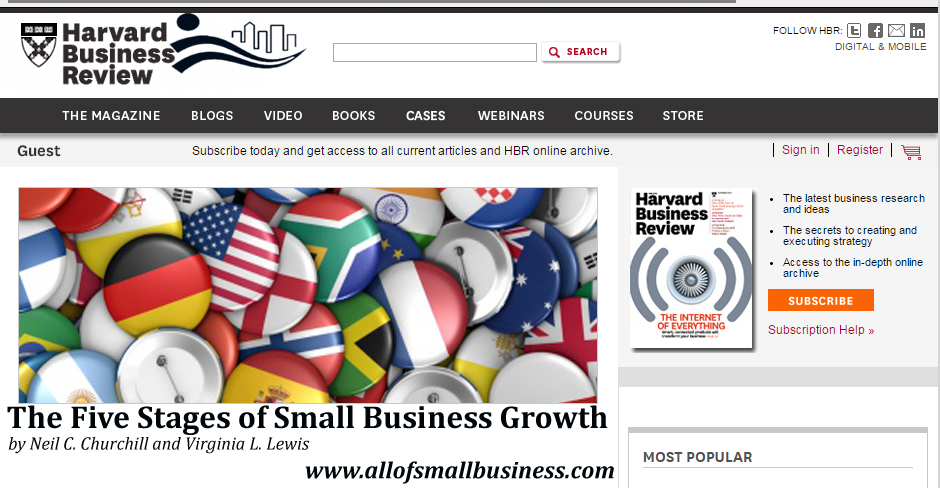Neil C. Churchill and Virginia L. Lewis
Harvard Business Review: The Five Stages of Small Business Growth

Categorizing the problems and growth patterns of small business growth in a systematic way that is useful to entrepreneurs seems at first glance a hopeless task. Small businesses vary widely in size and capacity for growth. They are characterized by independence of action, differing organizational structures, and varied management styles.
Yet on closer scrutiny, it becomes apparent that they experience common problems arising at similar stages in their development. These points of similarity can be organized into a framework that increases our understanding of the nature, characteristics, and problems of businesses ranging from a corner dry cleaning establishment with two or three minimum-wage employees to a $20-million-a-year computer software company experiencing a 40% annual rate of growth.
For owners and managers of small businesses, such an understanding can aid in assessing current challenges; for example, the need to upgrade an existing computer system or to hire and train second-level managers to maintain planned growth.
It can help in anticipating the key requirements at various points—e.g., the inordinate time commitment for owners during the start-up period and the need for delegation and changes in their managerial roles when companies become larger and more complex.
The framework also provides a basis for evaluating the impact of present and proposed governmental regulations and policies on one’s business. A case in point is the exclusion of dividends from double taxation, which could be of great help to a profitable, mature, and stable business like a funeral home but of no help at all to a new, rapidly growing, high-technology enterprise.
Finally, the framework aids accountants and consultants in diagnosing problems and matching solutions to smaller enterprises. The problems of a 6-month-old, 20-person business are rarely addressed by advice based on a 30-year-old, 100-person manufacturing company. For the former, cash-flow planning is paramount; for the latter, strategic planning and budgeting to achieve coordination and operating control are most important.
Developing a Small Business Framework
Various researchers over the years have developed models for examining businesses (see Exhibit 1). Each uses business size as one dimension and company maturity or the stage of growth as a second dimension. While useful in many respects, these frameworks are inappropriate for small businesses on at least three counts.

First, they assume that a company must grow and pass through all stages of development or die in the attempt. Second, the models fail to capture the important early stages in a company’s origin and growth. Third, these frameworks characterize company size largely in terms of annual sales (although some mention number of employees) and ignore other factors such as value added, number of locations, complexity of product line, and rate of change in products or production technology.
Neil C. Churchill is distinguished professor of accounting and director of the Caruth Institute of Owner-Managed Business at Southern Methodist University. He has authored or coauthored three other articles for HBR, the most recent two being: “Don’t Let Inflation Get the Best of You” (March–April 1982) and “Choosing and Evaluating Your Accountant” (with Louis A. Werbaneth, Jr., May–June 1979).
Virginia L. Lewis is a senior research associate of the Caruth Institute at SMU.
RELATED ARTICLES

Moms Build a Small Business on Better Tissues
In 2007, Julie Pickens and Mindee Doney found a $16 million business hiding in theirRead More

Ten ways small business owners can improve their financial literacy
As a small business owner, a deep understanding of your company’s financial situation drastically improvesRead More

Comments are Closed